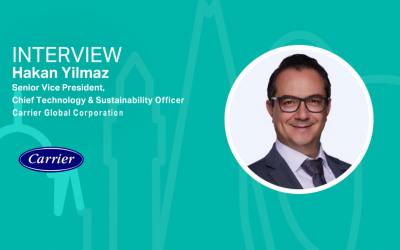Mary-Therese Barton on the role Emerging Market countries will play in the transition to net zero
After the Sustainable Investment Forum North America, Climate Action caught up with Mary-Therese Barton, Head of Emerging Debt at Pictet Asset Management, to discuss the role Emerging Market countries will play in the transition to net zero.

After the Sustainable Investment Forum North America, Climate Action caught up with Mary-Therese Barton, Head of Emerging Debt at Pictet Asset Management, to discuss the role Emerging Market countries will play in the transition to net zero.
Can you tell us more about the role Emerging Market countries will play in the transition to a greener global economy?
Emerging market countries have a significant role to play in the transition to a greener global economy. They rank among some of the largest emitters of greenhouse gasses – for example, China and India are the first and fourth largest emitters, emitting 26 per cent and 7 per cent of global greenhouse gases respectively1.
These numbers are even expected to climb. Of course, there is the consideration regarding how to measure this. For example, production-based accounting – assigning emissions where they are produced (favouring developed markets) or consumption-based accounting – assigning emissions to final consumers (favouring emerging markets). The emissions numbers quoted above for China and India follow the former approach. In addition, there is further consideration regarding development pathways, and how we should consider emerging vs. developed markets, where the latter have benefited from historical carbon intensive industrialisation.
Leaving the above considerations and debate aside, what is clear is that reduced emissions in emerging markets will be key to achieving net-zero. Without a green transition in emerging markets, global targets will not be met.
What are the particular challenges for Emerging Markets in their transition to a greener, equitable and more sustainable model?
Models show that emerging markets are among those most impacted by some of the adverse scenarios associated to climate change. Many large emerging markets are particularly vulnerable to physical climate change due to, among other things, their geographical location, population pressures, dependence on agriculture, macroeconomic vulnerabilities, and poorer infrastructure (including health capacity or transport for example). A study we conducted with the Oxford Smith School2 indeed showed that the economic output in countries such as India and Brazil could be lower by up to 60 per cent by 2100 in some scenarios. This will have a significant real economy impact on these countries.
To complicate the scenario even further, emerging markets are those often least in a position to finance this transition, mainly because of a lack of access to capital, fragile fiscal accounts, and high debt levels with high interest repayments.
What tools are at the debt investor’s disposal to aid in the transition to a greener and more equitable model?
Not only do emerging markets play a crucial part in achieving a longer-term sustainable global outcome, but broadly, at a high level, many models indicate that the risks of failing to reach this objective would have a much greater impact on these countries’ real economy.
As bond investors, focusing on long-term sustainability and creditworthiness, this real economic impact is an important consideration for the returns of our clients in emerging market bonds. The maturity profile of emerging market sovereign bonds has been increasing –the length of duration has increased from 6.5 years to 8 years since 20163. It is not uncommon for even some of the higher-yielding sovereigns to issue 30-year papers; we even see 100-year papers. As long-term investors, with a long-maturity asset class, we need to consider both the impact of climate change and how to price the real economic impact of not achieving the green transition.
We believe that key to this process is true integration of ESG considerations, away from a score, but embedded in the investment process and research culture of a team. In our view, this facilitates the assessment of the creditworthiness and valuation of a credit with this lens on longer-term sustainability issues. This also involves having specialised research to gain real insight through innovative partnerships, to understand the true risk of investment in a country for the long term via sovereign bonds, but also to unearth investment opportunities where we see clear progress and momentum on key sustainability trends. Engagement and dialogue with debt management offices (DMOs) around the importance of this transition, sometimes in one-on-one meetings and other times in collaboration with other asset managers, is an important tool for investors to support the transition. This is now on the agenda at debt roadshows with sovereigns. Of course, this begs the question of how to measure the impact of such interactions, which remains difficult.
What opportunities will this transition ultimately provide for Emerging Market investors?
The growth of emerging markets sovereign sustainability bonds over the last year plays a particular role for public market sovereign investors.
2020 saw both social and sustainable bond issuance in the sovereign space, as well as green bond issuance. Egypt was the first high-yield sovereign green bond issuance in US dollar (5 times oversubscribed at the end of 2020), and the trend continued in 2021 – with issuances in Chile, Colombia, Uruguay and Pakistan. Ghana, Peru, and others are still to come. A watershed moment occurred at the start of this year, when Chile announced that it will not be issuing plain vanilla Eurobonds – only green and social bonds.
These new issuances allow debt investors to directly consider use of proceeds meant to benefit the green transition. The added transparency (according to the frameworks provided) also enables them to monitor progress. As for DMOs, they choose to issue these bonds not only in view of increasing demand but also because it is a way for them to finance their transition at a lower cost.
In conclusion, there’s no doubt emerging market sovereign bond investors should assess the progress of the green transition globally and for individual countries as part of their standard creditworthiness analysis. This provides them with an opportunity to differentiate among a hugely diverse asset class. What’s new though is that emerging market debt investors are now being given the tools to directly finance the transition via sovereign green bonds. As a growing asset class with close to USD 34 trillion outstanding in tradeable debt, accounting for 23 per cent of the global debt market4, together with strong multilateral and broader developed country support, emerging markets will play an important role in the green transition globally.
[1] World Resources Institute, December 10, 2020
[3] Duration of the JPMorgan, EMBI Global Diversified Index, Bloomberg, September 2021
[4] Bank of America Securities, end 2020.
Pictet Asset Management spoke at the Sustainable Investment Forum North America 2021. Missed the session? You can watch it here on demand!






